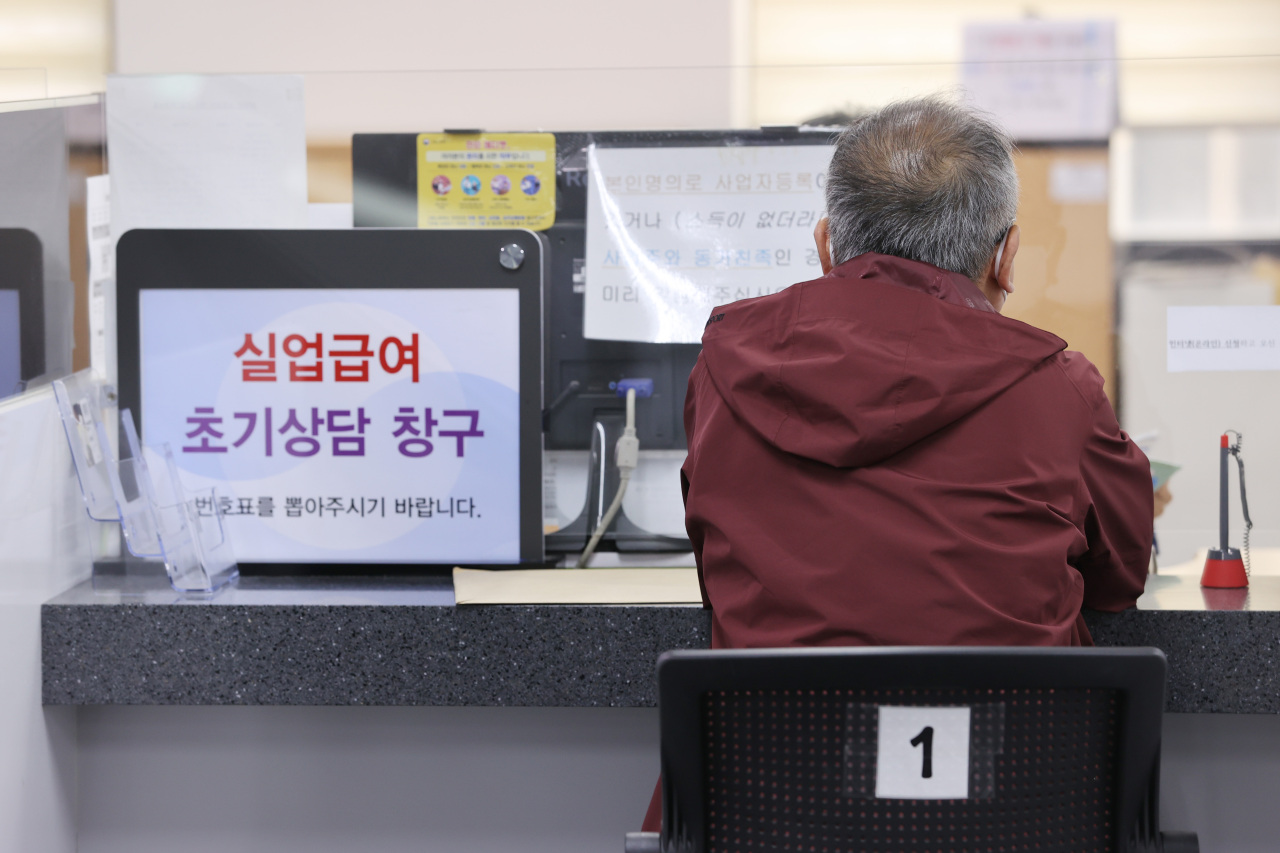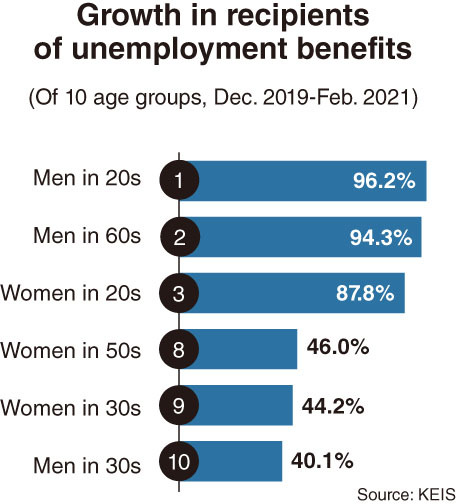 |
A man applies for unemployment benefits at a regional office of the Employment and Welfare Plus Center in Seoul earlier this year. (Yonhap) |
SEJONG -- Recent data from a state-funded agency suggested that South Koreans in their 20s and 60s took the hardest hit by the novel coronavirus in terms of job security, with a noteworthy disparity among generations -- or somewhat by gender in the same age groups -- being posted.
This is seen from a comparison of unemployment-benefit payouts to people who lost jobs or closed small businesses, offered by the Korea Employment Information Service. Its data provides the growth of the tally for benefit recipients by generation and sex.
Among the 10 major working-age groups -- those in their 20s, 30s, 40s, 50s and 60s by gender -- men and women in their 20s, and men and women in their 60s made up the top four in the growth of benefit recipients since December 2019, a month before COVID-19 initially hit the nation.
Men in their 20s topped the list as the number of recipients surged by 96.2 percent from 21,051 in December 2019 to 41,314 in February 2021. Male recipients in their 60s ranked second with a 94.3 percent increase -- from 56,729 to 110,228.
Over the corresponding period, the No. 3 and No. 4 were women in their 20s and women in their 60s, respectively, with an increase of 87.8 percent to 64,160 and 86.8 percent to 68,020.
 |
(Graphic by Kim Sun-young/The Korea Herald) |
This de facto means that young workers with weaker expertise and shorter careers were the main target of layoffs over the past year in the corporate sector. A Seoul-based employee at a tourism industry said that his “company had no choice but to initially dismiss people in their 20s in the second and third quarter of last year.”
In addition, many 20-somethings working as contract workers in the services industry involving convenience stores and coffee shops could be primary victims.
At the same time, a large portion of the self-employed are estimated to have closed their microbusinesses or suffered huge drops in sales. A large portion of Korean workers in their 60s are working in a nonregular job status or own microbusinesses.
“It is irrefutable that temporary or part-time workers in their 60s could be a core target of dismissal in this unexpected recession last year (negative GDP growth of 1 percent on-year),” a labor researcher said.
People in this occupation could also enjoy unemployment allowances when their sales plunge percentage meets the ceiling by the government, as long as they had paid premiums for the state-operating Employment Insurance.
No. 5 were male recipients in their 50s with a 57.2 percent increase during the December 2019-February 2021 period, followed by female recipients in their 40s at 55.4 percent.
Following on the list were men in their 40s at 48 percent and women in their 50s at 46 percent. Many of the benefit recipients in these two groups are estimated to have been self-employed.
KEIS data showed that male and female recipients in their 30s posted the lowest (40.1 percent) and second-lowest (44.2 percent) increase in the tally, though the figures are not negligible. This indicates that businesses relatively hesitated to lay off workers at a certain stage of their career.
More seriousness lies in the fact that a growing portion of the young generation have become self-employed, like food retailers or coffee shop owners in recent years.
Though the government has offered young small business owners subsidies like loans on low interest rates, the uncertainty over their survival in the market could mount should a longer-than-expected pandemic phase continue.
Meanwhile, more and more researchers raise the possibility that the state reserves for payouts for the jobless might deplete on a midterm basis amid continuous renewal of all-time highs in monthly or yearly payment balances.
By Kim Yon-se (
kys@heraldcorp.com)






![[Exclusive] Hyundai Mobis eyes closer ties with BYD](http://res.heraldm.com/phpwas/restmb_idxmake.php?idx=644&simg=/content/image/2024/11/25/20241125050044_0.jpg)
![[Herald Review] 'Gangnam B-Side' combines social realism with masterful suspense, performance](http://res.heraldm.com/phpwas/restmb_idxmake.php?idx=644&simg=/content/image/2024/11/25/20241125050072_0.jpg)

